Electromagnetism (Electric Fields) - Model Answers
1/36
There's no tags or description
Looks like no tags are added yet.
Name | Mastery | Learn | Test | Matching | Spaced |
|---|
No study sessions yet.
37 Terms
Explain how an insulating object can become charged.
Electrons can be transferred from one object to another.
Via friction.
The object gaining electrons becomes negatively charged.
Describe what is meant by an electric field.
A region where a charged particle experiences a force.
Define electric field strength.
The force per unit positive charge.
State the equation for electric field strength.
E = F/qsource
Where E is the electric field stregth.
F is the electrostatic force.
q is the charge of the charge placed within the field.
State whether the following are vectors or scalars.
Coulomb force
Electric field strength
Coulomb force - Vector
Electric field strength - Vector
Describe the direction of electric field lines.
Electric field lines point in the direction that a positive point charge would experience a force. (*from +ve to -ve).
Draw the electric field around a positive point charge.
Radial field.
Electric field strength decreases with distance from charge (field lnes become further apart).
Field lines meet charge at right angles to its surface.
Arrows point in the direction that a positive point charge would experience a force (away from +).
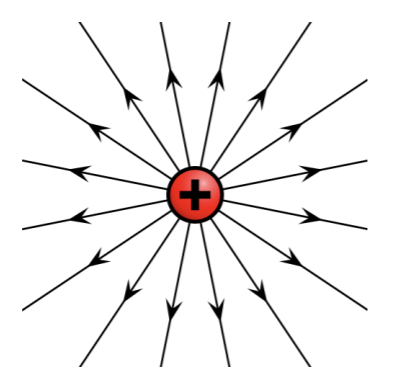
Draw the electric field around a negative point charge.
Radial field.
Electric field strength decreases with distance from charge (field lnes become further apart).
Field lines meet charge at right angles to its surface.
Arrows point in the direction that a positive point charge would experience a force (towards -).
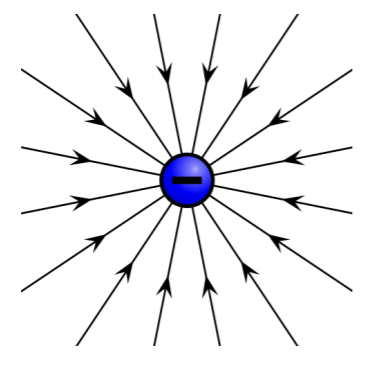
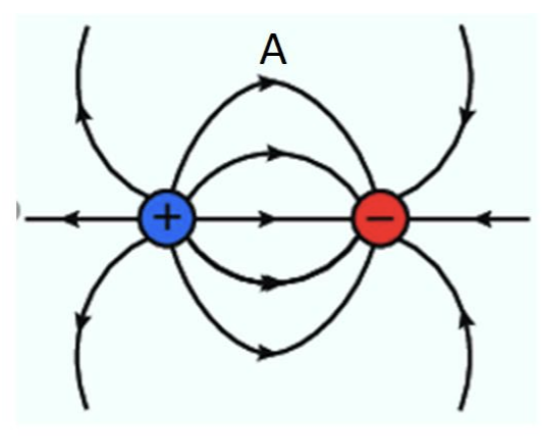
Show how the electric field vector at A has been constructed.
Step 1 - Draw the electric field vectors sue to the positive and negative charge (E+ and E- respectively).
*Note the vectors are the same length because point A is the same distance from each charge.
Step 2 - Draw the electric field vectors due to the positive and negative charges (E+ and E- respectively).
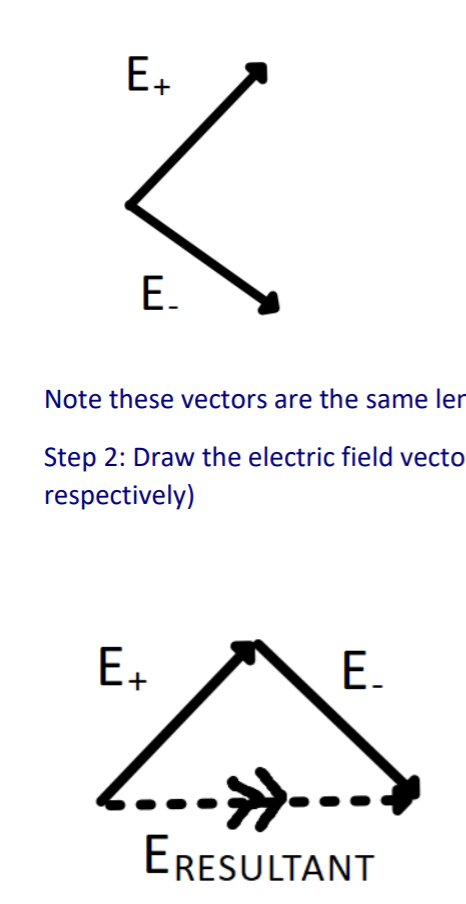
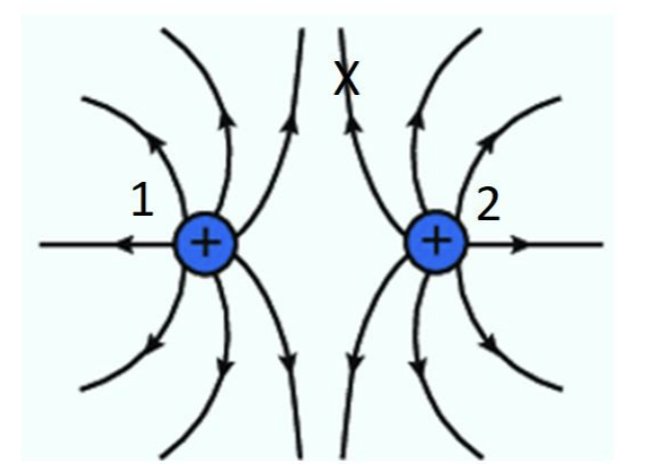
Show how the electric field at X has been constructed.
Step 1 - Identify the electric field vectors due to charge 1 and charge 2.
*Note that E1 is shorter in length than E2, as the point we are considering is further from charge 1 than charge 2.
Step 2: Vector diagram.
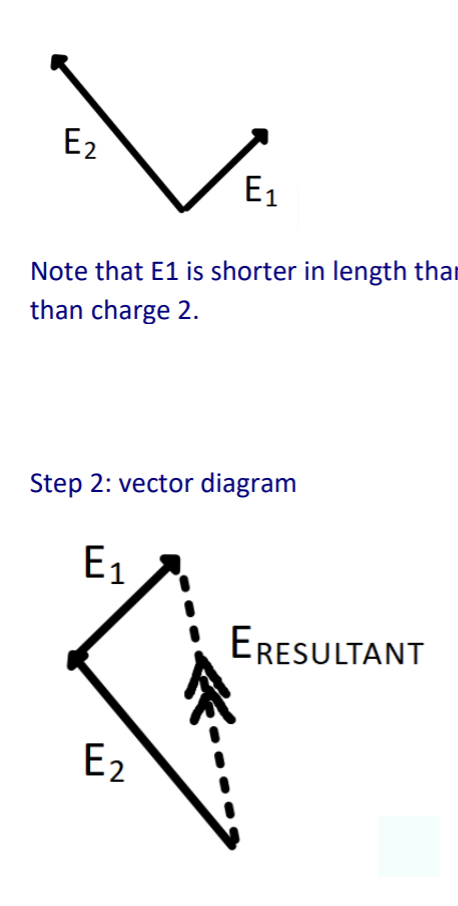

Draw the electric field lines between a positive point charge and nagative place.
Charges coming in all directions.
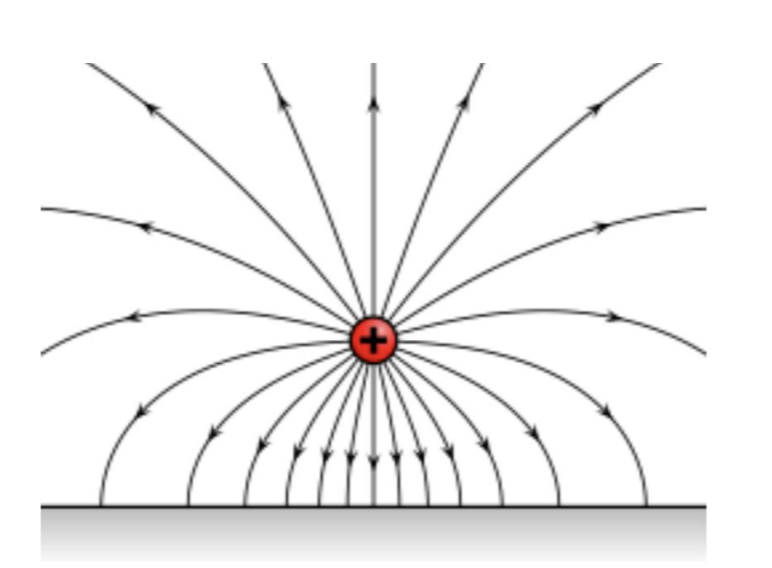
Define unifrom electric field.
A field in which the electric field strength is constant everywhere.
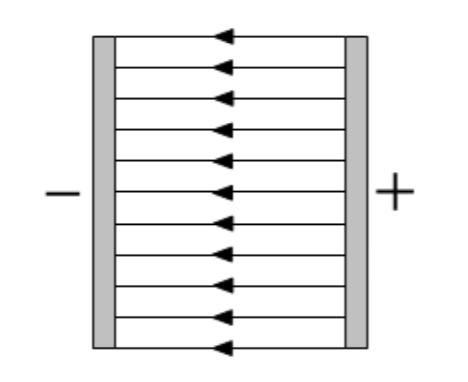
Draw the electric field between two infinite parallel plates.
Key points to note:
Arrows from + to - (as this is the direction of a +charge would experience.
Field lines equidistant (as the electric field strength is presented by the clossness of field lines, and this is constant).
Field lines meet plates perpendicular to the plate.
State the equation for the electric field in a uniform field.
E = V/d.
Where E was the electric field strength.
V is the potential difference across two plates.,
d is the seperation between the two parallel field.
Derive the expression for the charge q on an oil drop that is held stationary within an uniform electric field.
W = Fe
mg = Eq
mg = Vq/d
q = mgd/V
q = 4/3 πr3ρgd / V
Explain how Millikan dertermined the radius of the oil drop in his experiment.
Let the oil drop fall through air at terminal velocity.
Use v = s/t to determine the terminal velocity.
At terminal veocity, W = F (Stroke’s drag force).
mg = 6πrηv
4/3 πr3ρg = 6πrηv
r2 = 9/2 ηv / ρg
Calculate the speed of an electron that has been accelerated by a pd of 500V. Electron charge = 1.6 × 10-19 C, electron mass = 9.11 × 10-31kg.
Work done = kinetic energy gained.
Vq = ½ mv2
500 × 1.6 ×10-19 = ½ x 9.11 × 10-31 v2
v = 1.3 × 107 ms-1.
Define thermionic emission.
Release of electrons from the surface of a metal due to heating.
![<ol start="19"><li><p>The diagram below show the structure of a linear accelerator (LINAC). </p><ul><li><p>Explain what the LINAC does to the motion of charged particles as they pass from one drift tube to another. [3]</p></li><li><p>Describe the motion of the charged particle inside the drift tube. [3]</p></li><li><p>Explain why the power supply should be alternating. [1]</p></li><li><p>Describe what the frequency of the alternating supply should be. [2]</p></li><li><p>Explain why the length of the tube increases. [3]</p></li></ul></li></ol><p></p>](https://knowt-user-attachments.s3.amazonaws.com/130551b7-de3d-4cd6-a64d-d244f0ef214b.png)
The diagram below show the structure of a linear accelerator (LINAC).
Explain what the LINAC does to the motion of charged particles as they pass from one drift tube to another. [3]
Describe the motion of the charged particle inside the drift tube. [3]
Explain why the power supply should be alternating. [1]
Describe what the frequency of the alternating supply should be. [2]
Explain why the length of the tube increases. [3]
The electric field acts in the gaps between the drift tubes [1], this causes a resultant force on the charged particle towards the target [1]. Due to Newton’s second law, this causes an acceleration to the right in between the tubes [1].
Inside the drift tube, there is no electric field [1], so the charge experiences no resultant force [1], and due to Newton’s first law, it moves with a constant velocity [1].
Power supply alternates to ensure the potential of each tube alternates. This ensures the electric field continues to accelerate the charge between tubes through appluing a force towards the target at each gap.
The frequency should be equal to 1/(2 time in tube), so that the potential of each tube changes just as the charge arrives at the end of the tube [1]. As the time in tube is low, the alternating supply frequency should be high.
As the charged particles accelerates, its speed increases [1]. To ensure it spends the same time in each tube [1], the tube length must increase by the same factor that the speed has, as time distance / speed.
An electron beam enters a uniform electric field consisting of two plates separated by 10cm with a potential difference of 300V. The electron beam has horizontal velocity of 2.9 × 107 ms-1. Calculate the vertical deflection of the electron beam after it has travelled 20cm.
Horizontally there is no acceleration. So:
s = ut
0.2 = 2.9 × 107t
t = 6.8965 × 10-9 s
Vertical acceleration:
F = Eq = Vq/d = 300 × 1.6 × 10=19 / 0.1 = 4.8 × 10-16N.
F = ma
4.8 × 10-16 = 9.11 × 10-31 x a
a = = 6.8965 × 10-9 s
Vertical deflection:
s = ?
u = 0 ms-1
v =
a = 5.2 × 1014 ms-1
t = 6.8965 × 10-9 s
s = ut + ½ at2
½ at2 = ½ x 6.8965 × 10-9 s x (6.8965 × 10-9 s)2
= 0.0128 m
= 1.28 cm
State Coulomb’s Law.
F = kq1q2/ r2
Where F is the electrostatic force
k is Coulomb’s constant = 8.99 × 109 Nm2C-2
r is the sepeartion between the centres of the charges
Derive the base unit for k.
k = Fr2 / q1q2
[k] = [F] [r]2 / [Q]2 = Nm2C-2
Base units are: m, s, A, kg
So N = kgms-2 and C= As
[k] = kgms-2m2A-2s-2
= kgm3s-4A-2
Describe the relationship between force and separation between charges.
The force is inversely proportional to the square of the separation (inverse square law).
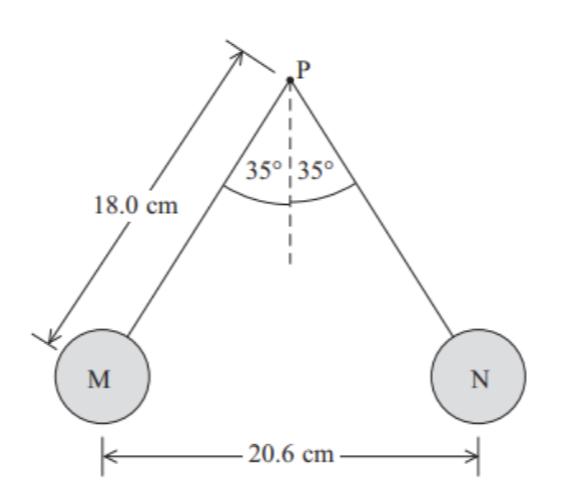
Two identical table tennis balls, M and N, are attached to non-conducting threads and suspended from a point P. The balls are each given the same positive charge and they hang as shown in the diagram. The mass of each ball is 2.7g.
a) Draw a force arrow diagram for charge M.
b) Calculate the charge on each of the charges.
a) Tension in the string, repulsive electrostatic force, weight (mg)
b)
Resolving forces vertically:
Tvertical = mg
T cos35 = 2.7 ×10-3 × 9.81 = 0.026487
T = 0.0323 N
Resolving forces horizontally:
Thorizontal = Felectrostatic = kq1q2 / r2
As each charge has the same charge, q1 = q2 and:
Thorizontal = Felectrostatic = kq2 / r2
0.0323 sin35 = 8.99 × 109 x q2 / (20.6 × 10-2)2
Q = 2.957 × 10-7 C = 3.0 × 10-7 C
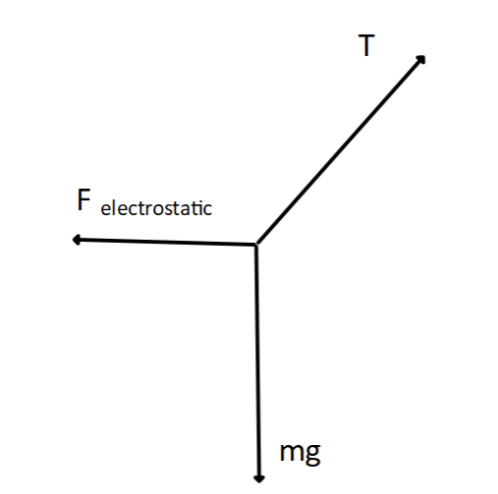
Derive the expression for the electric field strength in a radial field.
F = kq1q2 / r2
E = F/q (from the definition of field strength)
E = kq1q2 / r2q
E = kq / r2
Where k is Coulomb’s constant, q is the charge creating the field, r is the distance from the centre of the charge q.

Prove the relationship between electric field strength and separation, as shown in this graph, obeys the inverse square law.
If E and r follows the inverse square law, then Er2 should be a constant as E = constant / r2
E1r12 = 11 ×1011 x (3.6 ×10-11)2 = 1.43 ×10-9 NC-1m2
E2r22 = 4 ×1011 x (6.0 ×10-11)2 = 1.44 ×10-9 NC-1m2
E3r32 = 2 ×1011 x (8.4 ×10-11)2 = 1.41 ×10-9 NC-1m2
Er2 is a constant to 2sf, hence E and r follow the inverse square law.
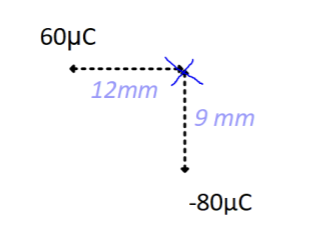
Determine the resultant electric field strength at position X.
Let the 60μC charge be Q1 and the -80μC charge be Q2.
E1 = kQ1/ r12 = 8.99 ×109 × 60 ×10-6 / (12 ×10-3)2 = 3.75 ×109 NC-1
E2 = kQ2/ r22 = 8.99 ×109 × 80 ×10-6 / (9 ×10-3)2 = 8.88 ×109 NC-1 (ignore sign)
Magnitude of resultant (use Pythagoras):
Etotal = √(3.75 ×109)2 + (8.88 ×109)2 = 9.64 ×109 NC-1
Direction (use trigonometry):
θ = tan-1 (8.88 ×109 / 3.75 ×109 )
= 67.1 degrees below horizontal
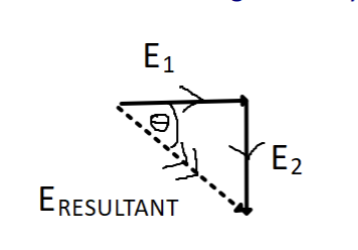
Define electric potential.
The work done per unit positive charge, in bringing a charge from infinity to a point within the field.
Explain why the electric potential is positive for positive charges and negative for negative charges.
In bringing a positive test charge from infinity to a point within the field around a positive charge, work has to be done against the field.
This is because the test charge would experience a repulsive electrostatic force in the opposite direction to its displacement.
So the test charge would gain electrical potential energy as it moves closer to the field creating positive charge (transferring it from kinetic energy).
Whereas when a positive test charge is brought closer to a negative field creating charge, the test charge would experience an attractive electrostatic force towards the negtive field creator.
Therefore work would be done by the field.
The charge’s electrical potential energy would decrease (it would be transferred into kinetic energy) as it gets closer to the negative charge.
Sketch a graph of potential against separation from
a) a positive charge
b) a negative charge
Inversely proportional graph for positive region - Positive charge
Reflected in x axis - Negative charge
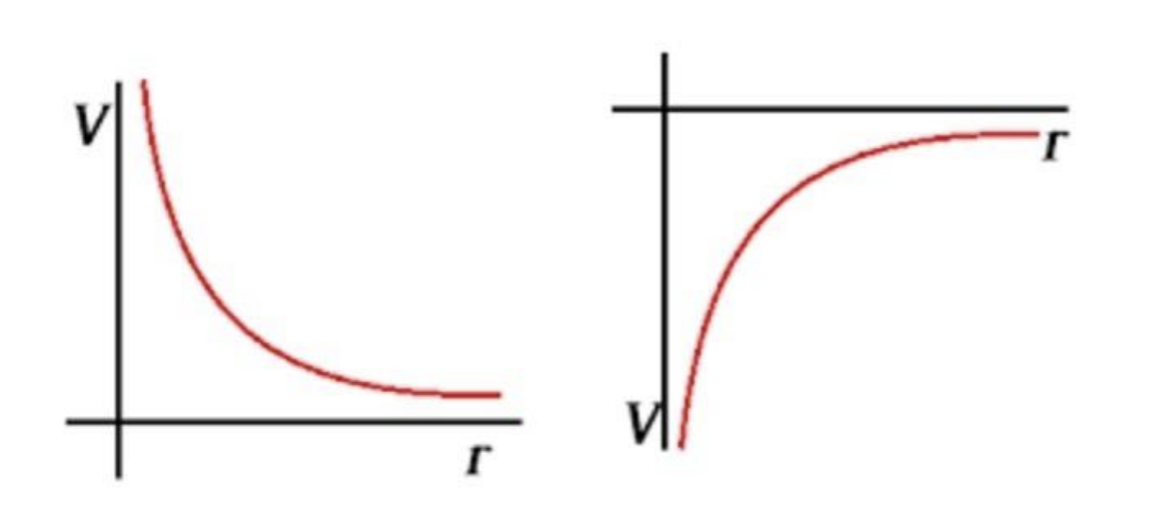
Describe the relationship between electric potential, V and seperation, r.
Potential and separation are inversely proportional.

Determine the potential at position X due to charges Q1 and Q2.
Vtotal = V1 + V2
Let the 60μC charge be Q1 and the -80μC charge be Q2.
V1 = kQ1/ r1 = 8.99 ×109 × 60 ×10-6 / 50 ×10-3 = 10,788,000 V
V2 = kQ2/ r2 = - 8.99 ×109 × 80 ×10-6 / 40 ×10-3 = - 17,980,000 V (KEEP SIGN)
Vtotal = V1 + V2 = -7,192,000 = 7.192 ×106 V
State the equation showing the relationship between electric potential and field strength.
E = -∆V / ∆r
E is the electric field strength
∆V is the change in potential for a charge, in distance ∆r
David Blaine wore a metal suit and was placed in a room with a charged sphere that cuased ionisation at 1m. A scientist claims that David Blaine is completely safe inside the metal cage. Comment on this suggestion. [4 marks].
There is no potential difference across the cage or his body.
Electric field strength inside the cage is zero (it is a Faraday Cage).
This is because there is no potential gradient.
Current conducts only on the surface of the cage - not inside.
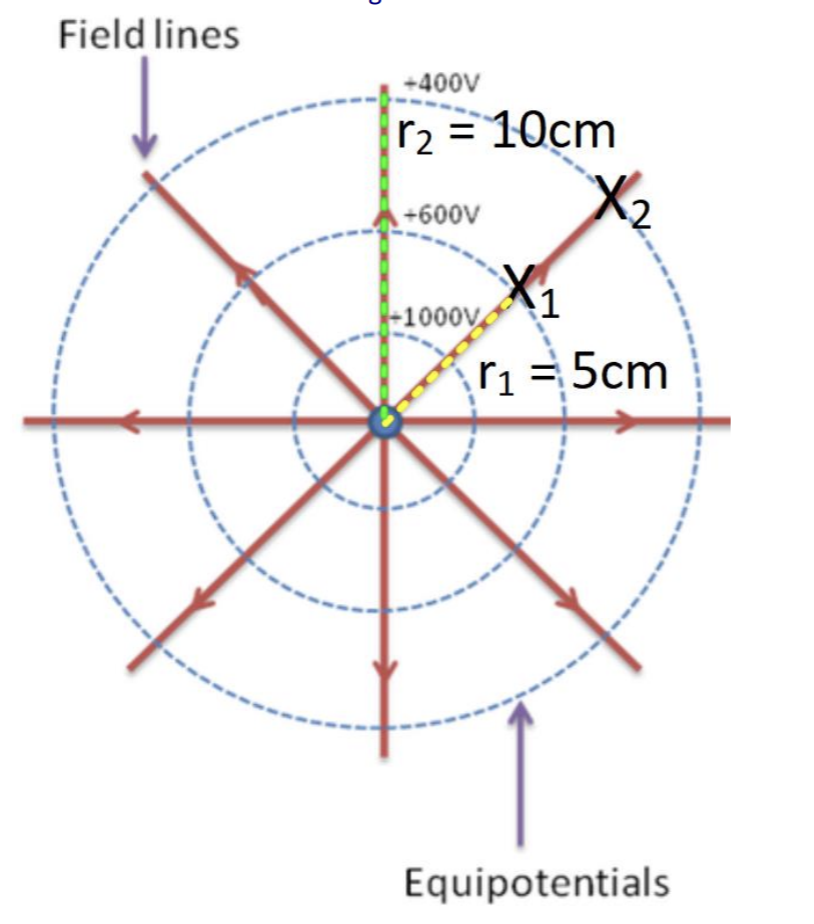
Determine the electric field strength between X1 and X2.
E = ∆V/ ∆r = (600 - 400)/ (10 - 5) x10-2 = 4000 Vm-1
Explain how to determine the electric field strength from a graph of potential against separation.
Electric field strength is the nagtive gradient of a potential, distance graph.
If the potential, distance graph is a curve, then the tangent at a point should be drawn and the gradient of this should be found.
Calculate the minimum separation between an alpha particle and a gold nucleus if the alpha particle is fired with an energy of 10MeV. The gold nucleus has an atomic number of 79.
KE of alpha particle = 10 × 106 × 1.6 × 10-19 J = 1.6 ×10-12 J
Decrease in KE of alpha = increase in EPE of alpha
1.6 ×10-12 = Δ Vq
where q is the charge of the alpha particle, q = 2 × 1.6 × 10-19 = 3.2 × 10-19C (as the alpha particle contains two protons)
ΔV = ΔV2 - V1, where V2 is the final potential (when stationary at the closest point) and V1 is the initial potential.
Assuming the alpha particle starts at infinity V1 = 0V
Taking the minimum distance of the closest appraoch to be r.
V2 = kQ/r where Q is the charge on the gold nucleus (field creator).
Q = 79 x 1.6 × 10-19 = 1.264 × 10-17 C (as the gold nuclus contains 79 protons)
So:
1.6 × 10-12 = kQq/r (combining the equations together)
1.6 × 10-12 = (8.99 × 109 × 1.264 × 10-17 x 3.2 × 10-19) / r
r = 2.27 × 10-14m